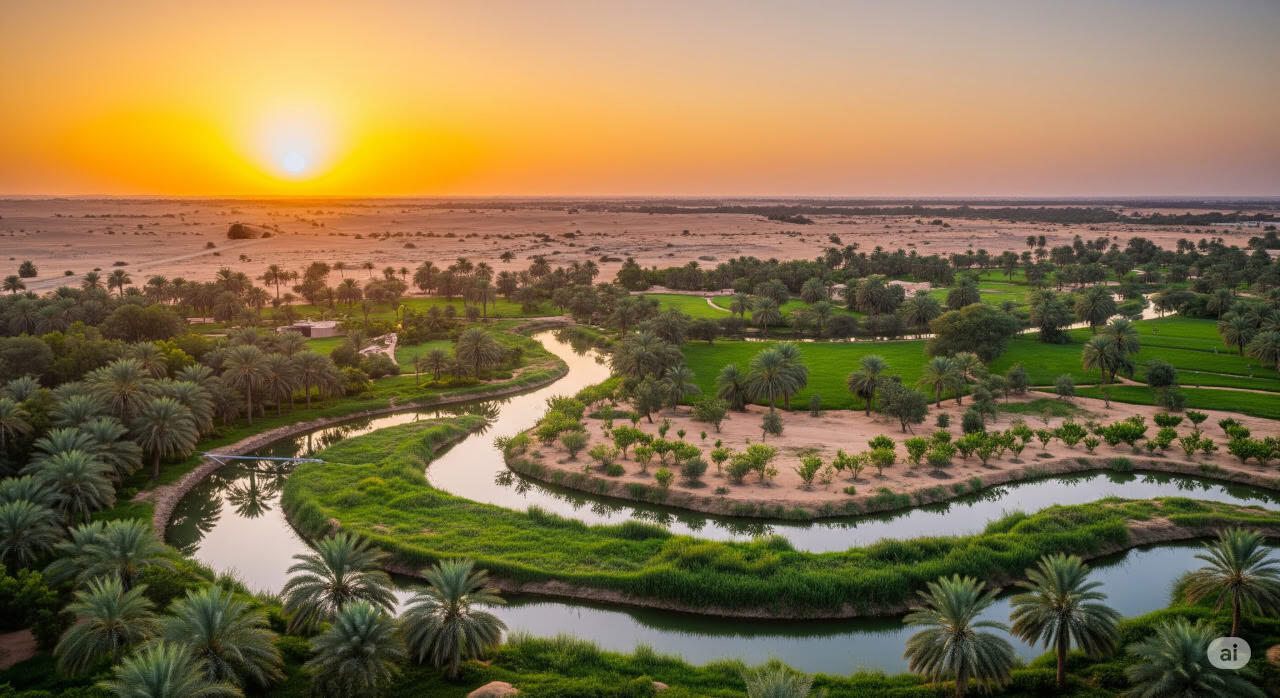Saudi Arabia’s Hidden Oasis: Turning Deserts into Lifelines with Underground Rivers

A Desert Transformed
Picture a land where rain is a rare guest, where rivers and lakes are mere myths, and yet, beneath the scorching sands, millions of gallons of water flow through a man-made marvel. This isn’t science fiction—it’s Saudi Arabia in 2025, a nation that has defied its arid destiny to create an underground river system that rivals the Nile in length. With no natural freshwater sources, Saudi Arabia has turned to audacious engineering, tapping ancient aquifers, building massive dams, and constructing a vast network of pipelines to pump desalinated seawater across its deserts. The result? A country once crippled by water scarcity is now reimagining its future, greening its landscapes, and securing a lifeline for its growing population. But at what cost, and can it last? Let’s dive into this extraordinary story of innovation, ambition, and the delicate balance between survival and sustainability.
The Water Crisis: A Desert’s Dilemma
Saudi Arabia is one of the driest places on Earth. With annual rainfall averaging just 100 millimeters (4 inches) in many regions, and summer temperatures soaring to 122°F (50°C), water is more precious than oil in this desert kingdom. The country has no natural rivers or lakes, and its wadis—dry riverbeds—fill only briefly during rare seasonal floods. Historically, this scarcity shaped a harsh reality: cities struggled, agriculture faltered, and water shortages were a constant threat. Yet, beneath the surface lies a hidden treasure—26 trillion gallons of groundwater, trapped in ancient aquifers from a time when the Arabian Peninsula was wetter, thousands of years ago.
This groundwater, however, is a double-edged sword. Only a small fraction—about 739 billion gallons per year—is renewable, replenished by scant rainfall. The rest is fossil water, locked underground for millennia, non-renewable once extracted. Saudi Arabia’s growing population, projected to rise from 35 million in 2024 to over 40 million by 2050, consumes water far beyond this renewable supply. Drinking, sanitation, irrigation, industry, and even luxury uses like green parks and car washing drive demand to unsustainable levels. Without intervention, the kingdom risks draining its aquifers, leaving future generations parched.
Dams: Capturing the Elusive Rain
To tackle this crisis, Saudi Arabia has turned to ingenuity. Since 2021, the country has built 522 dams, designed to capture the rare but intense rainfall that can flood wadis. These dams, with a collective storage capacity of 650 billion gallons, are a lifeline, channeling seasonal floods into reservoirs for treatment and distribution. In Mecca province alone, 60 dams hold 232 billion gallons, supporting flood control, irrigation, and local water supplies. The Holly Dam, the second largest in the country, boasts a reservoir capacity of 249.86 million cubic meters, a testament to Saudi Arabia’s commitment to harnessing every drop.
These dams are more than engineering feats—they’re a strategic response to the desert’s extremes. Without them, rainwater would evaporate under the relentless sun or rush uselessly across the sands. By storing and treating this water, Saudi Arabia has turned fleeting storms into a reliable resource, supplying entire cities during dry spells. But dams alone can’t meet the kingdom’s needs, especially as rainfall remains erratic and unpredictable.
The Underground River: A Man-Made Marvel
Faced with limited rainfall and depleting groundwater, Saudi engineers devised a radical solution: an underground river system, not of natural water, but of desalinated seawater pumped from the Red Sea and Persian Gulf. Spanning 8,700 miles—longer than the Nile’s 4,135 miles—this network of pipelines is a staggering achievement. Unlike surface canals, which lose water to evaporation in Saudi Arabia’s brutal heat, these deep-buried pipes preserve water quality, maintain pressure, and deliver it efficiently to inland cities like Riyadh, Jeddah, and Mecca.
Constructing this “invisible river” was no small feat. Engineers carved through the Hijaz Mountains, using tunnel-boring machines and controlled explosions to blast through dense granite and limestone. In the central deserts, where temperatures exceed 122°F, workers toiled at dawn or overnight to avoid heatstroke. Shifting sand dunes, dust storms, and flash floods added to the challenges, requiring deep trenching and soil stabilization to secure the massive pipes, some over 2 meters wide. This system isn’t just infrastructure—it’s a lifeline, ensuring water reaches urban centers and industrial zones far from the coast.
Desalination: Turning Salt into Sustenance
The backbone of this underground river is desalination, the process of removing salt from seawater to make it drinkable. Saudi Arabia, the world’s leading producer of desalinated water, operates 43 desalination plants as of 2024, up from 30 in 2011. The Ras Al-Khair plant, a $7.2 billion behemoth on the eastern coast, holds a Guinness World Record as the largest of its kind, producing 792 million gallons of fresh water daily—enough for millions of residents and industries. The Jubail plant, another giant, churns out 211 million gallons daily, cementing Saudi Arabia’s dominance in the Gulf region, where the UAE trails with its own large-scale facilities.
Desalination, however, comes with trade-offs. It’s energy-intensive, often relying on non-renewable sources, making it 3–10 times more expensive than traditional water sources. The process also produces brine, a highly concentrated saltwater byproduct that can harm marine life if mismanaged. Despite these challenges, desalination is non-negotiable for Saudi Arabia, where natural freshwater is virtually nonexistent. By 2024, the kingdom treats and reuses 1.3 billion gallons of wastewater daily, with projections of 4% annual growth through 2050. Yet, even this won’t keep pace with rising demand.
Greening the Desert: A Vision for the Future
Saudi Arabia’s water innovations are part of a broader transformation, epitomized by the Saudi Green Initiative. Launched to combat desertification, this ambitious program aims to protect 30% of the country’s land and plant 10 billion trees, greening 184 million acres. By 2024, hundreds of millions of trees have been planted, with pilot projects restoring vulnerable desert zones. This isn’t just about aesthetics—it’s about survival. Trees improve soil fertility, enhance food security, and act as barriers against desert expansion. In urban centers like Riyadh and NEOM, green infrastructure reduces heat trapped in concrete, lowering street temperatures by up to 3.96°F—a small but critical relief in a country where 122°F is routine.
The initiative also tackles air quality. Tree planting can reduce PM2.5 and PM10 particles—linked to respiratory illnesses—by up to 20%, depending on local conditions. Cities are integrating green spaces into their designs, improving livability and signaling a shift toward sustainability. This transformation reflects a new national identity, one that looks beyond oil to a future where the desert blooms.
The Fragile Balance: Can It Last?
Saudi Arabia’s achievements are remarkable, but they come with a warning. The kingdom’s reliance on non-renewable fossil water risks depletion, with some estimates suggesting aquifers could dry up within decades. Desalination, while effective, is costly and environmentally taxing. The underground river system, a marvel of engineering, depends on continued investment and maintenance in a harsh climate. As the population grows and urban centers expand, water demand will only intensify.
The Saudi Green Initiative offers hope, but planting 10 billion trees in a desert is a long-term gamble, requiring massive water resources and decades to mature. Climate change, with its unpredictable rainfall and rising temperatures, adds further uncertainty. Saudi Arabia’s water strategy is a high-stakes balancing act: leveraging technology to defy nature while racing against time to build a sustainable future.
A Lesson in Resilience
Saudi Arabia’s story is one of human ingenuity pushing the boundaries of possibility. By capturing fleeting rains, tapping ancient aquifers, and building an underground river longer than the Nile, the kingdom has turned a water-scarce desert into a hub of urban and agricultural life. The Saudi Green Initiative, with its vision of a greener, more livable country, underscores a commitment to future generations. Yet, the challenges—depleting groundwater, costly desalination, environmental risks—remind us that even the most ambitious solutions are fragile.
What can the world learn from Saudi Arabia’s bold experiment? It’s a testament to what’s possible when necessity meets innovation, but also a cautionary tale about living within nature’s limits. As we face our own resource challenges globally, Saudi Arabia’s underground oasis asks us to consider: How far can we push technology to reshape our environment, and at what point must we adapt to the world as it is?



